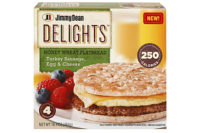Product Development Solutions: It's a soy world

If pork is the “other white meat” and beef is “what’s for dinner” - what is soy?
According to industry experts, soy is becoming, well, just about everything. High in protein, low in fat and credited with aiding heart health, soy is turning up as a healthy ingredient in more products.
A recent study by Packaged Facts, a New York-based research firm, found that the soy food and beverage market grew 6 percent between 2006 and 2007 for a total of more than $2 billion. In the report, “Soy Foods and Beverages in the U.S.,” Packaged Facts predicts that the soy market will continue to rise through 2012 when it is expected to reach $3 billion.
Further, the United Soybean Board reported in its annual survey, “Consumer Attitudes about Nutrition - Insights into Nutrition, Health &Soyfoods,” that 33 percent of Americans now consume soy-based foods or beverages once a month or more.
Experts say widespread consumer awareness of soy products’ health benefits and the wide range of new soy-based applications are fueling this growth.
A healthy choice
“Consumer awareness of soy as a healthy food has dramatically increased during the past decade,” said Tatjana Meerman, publisher of Packaged Facts in a statement about the survey.
In fact, 85 percent of consumers now identify soy products as healthy, reports the United Soybean Board, St. Louis. This accounts for a 3 percent rise over 2006 and an 18 percent increase during the last nine years. Specifically, the Soybean Board’s report indicates that consumers recognize that soy foods are: low in fat (18 percent), high in protein (17 percent), help heart health (16 percent), lower cholesterol (11 percent) and potentially relieve menopause symptoms (10 percent).
Greater consumer familiarity with these health benefits has created a unique opportunity for soy protein suppliers and soy product processors.
“Rather than just targeting vegetarians, today it is about bringing in new consumers - meat reducers, health conscious - into the category,” says Al Gallegos, director of global business development for The Solae Co., a St. Louis, Mo.-based marketer of soy-based protein ingredients.
In order to bring in new non-vegetarian users, processors need to emphasize - not only health - but also high quality and new flavors, Gallegos says.
“The key to growth is creating meatless cuisine with an eating quality and a protein content - similar to a meat-containing counterpart - but with reduced calories, fat, saturated fat and cholesterol,” he says.
Innovative applications
There are several new products capitalizing on soy’s health benefits, while also delivering on innovation. Launched this March, Kellogg’s Morningstar Veggie Cakes combine vegetables, rice, soy protein and spices to create a low fat, high protein entrée (when combined with salad), snack or appetizer, says the Kellogg Co., Battle Creek, Mich.
Gardenburger, also owned by Kellogg, added to its vegetarian offerings with Gardenburger Gourmet Garden Steaks last year. Kellogg says these 156-gram “steaks” come in four exotic spice varieties: Baja (chilies and pepper jack), Fire Dragon (jasmine rice, Asian vegetables), Hula (pineapple and ginger) and Tuscany (Gorgonzola and couscous).
Helen’s Kitchen, Irvine, Calif., also expanded its soy-packed vegetarian offerings this year. The Helen’s Kitchen Comfort Meals line includes Mac & Cheese with Tofu Steak & Broccoli and Hearty Chili - both of which are made with tofu steaks rich in protein, calcium, fiber, iron and vitamins A and C, the company says.
For its part, Solae planned to showcase Mini Barbeque Vegetarian Beef Sandwiches, in addition to a smoothie and protein bar, at the Institute of Food Technologists’ Annual Meeting & Food Expo in New Orleans this summer. Featuring shredded vegetarian “beef” and tangy barbeque sauce, the product is made with Solae’s Supro Max - a form of protein that “emulates whole-muscle meat texture - chewiness, fibrosity and appearance,” Gallegos says.
And for those with a big appetite, Turtle Island Foods, Hood River, Ore., launched Foot Long Veggie Dogs this summer. This product is made with a blend of organic tofu and extracted soy protein isolates and concentrates. The vegetarian hot dogs come in Original and Chipotle flavors and feature a “meaty texture and rich poultry style taste,” Turtle Island says.
Early opportunity
While research indicates that consumers are most enthusiastic about consuming soy products for dinner - 41 percent per the United Soybean Board - the second most popular occasion is breakfast at 28 percent.
Last year, Solae commissioned research to investigate consumer amenability to breakfast as a possible soy-eating occasion and found that this is an opportunity for growth.
“In our study, consumers’ desires for breakfast foods that ‘fill them up’ and ‘keep them energized’ are two of the more significant opportunities we uncovered,” said Jean Heggie, Solae director of marketing, in a statement about the study. “The relevance of soy protein in particular to these needs is its ability to deliver sustained energy and satiety benefits as a high-quality, plant-based protein.”
Other opportunities for growth exist for meatless, soy-based products that boast additional product claims.
Gallegos explains, “We clearly see consumers looking for a variety of [soy] food products. … We see consumers’ willingness to try new things, in particular finding new products that are ‘sustainable’ or ‘natural.’ We’re seeing this in vegetables, fruits and cereal, and we think more consumers will take an active role in understanding how their meal is brought to the table.”
Looking for a reprint of this article?
From high-res PDFs to custom plaques, order your copy today!



